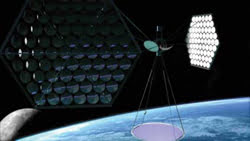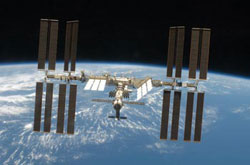The sun shines 24/7 in outer space, so it is not surprising that solar power seekers worldwide are setting up shop out there – or at least taking steps in that direction.
Solar power drawn from space-based satellites is not a new concept. It was presented in the journal Science in 1968 and patented by Dr. Peter E. Glaser in 1973. During the energy crisis of the 1970s, the US Department of Energy studied space-based power, proving that, although technically feasible, it was economically impractical and less efficient than other forms of energy.
In the 1990s, NASA revived the concept with the “Fresh Look” study and, by 2007, with a revived focus on renewable energy sources, many groups – both government and industry – had stepped up the studies and the investment. Over the course of three decades, the US government and NASA have collectively invested about $80 million in the study of space-based solar.
The most common approach to space-based solar power generation would place satellites into geostationary orbit – a 24-hour revolution synchronized with the Earth’s rotation – at an altitude of 22,500 miles. The satellite would be equipped with photovoltaic solar panels that would collect sunlight and, using solid-state power amplifiers, would convert the solar power to 2.45- or 5.8-GHz microwaves that would be beamed to a receiver on Earth. The receiver, called a rectenna, would convert microwave energy into electricity, which would be sent to a local power grid.

The concept of gathering the sun’s energy in outer space and beaming it to Earth is getting closer to reality. Courtesy of Mafic Studios Inc.
John C. Mankins, who formerly managed NASA’s space solar power studies and who now owns Managed Energy Technologies of Ashburn, Va., said that this is no small undertaking. Speaking with Jeff Young on National Public Radio’s “Living on Earth” program, he said that the transmitter would measure about a half mile across, or the equivalent of approximately 20 international space stations. The beam would be about a half mile wide in space and would spread to about four miles wide when received on Earth.
“You’d certainly want to take the right precautions, keep the energy density, the amount of power that’s in a square meter of the beam low enough to be safe,” he told Young.
Not without challenges
As with the development of all forms of solar power, a huge challenge is generating power cheaply, reliably and safely. Generating it in space adds variables, including finding materials that can withstand high temperatures, placing huge satellite transmitters into space and placing receivers on Earth, and ensuring that the beams sent to Earth are not harmful to humans or to the environment.
Research and development costs aside, the biggest ticket item is expected to be the cost of launching the satellites. Space Energy AG of Switzerland has made great strides toward developing its solar-from-space concept, and its business plan allocates about $125 million just to hoist its satellite into space.
The beam of microwave energy would measure a mile or two across and would pass through the atmosphere easily. Some energy would be lost, although exactly how much is not yet known, and skeptics could raise disaster-ridden questions: What if the beam strays? Could birds or humans be harmed? Would the beam affect weather or cause other changes to the environment?
Dr. James Logan, former chief of medical operations at NASA’s Johnson Space Center, has studied these issues and has answers to many of the questions: If the beam strayed, for example, it could be defocused. If birds passed through the beam, they would feel some warmth, but microwave radiation is nonionizing and cannot make a charged particle that would damage DNA or biomolecules.
Signing up
Pacific Gas and Electric Co. (PG&E) of San Francisco recently signed a supply agreement with Solaren Corp. of Manhattan Beach, Calif., for 200 MW of electricity generated in space and transmitted by microwave beam to a receiving station in Fresno County, Calif. The contract calls for the power to begin to flow in 2016.
In an interview posted on PG&E’s Next100 Web site, Solaren CEO Gary Spirnak said he is confident that, by using proven technology and designs, and through extensive testing, the company will be able to deliver on the contract.
Others also are working to commercialize space-based solar power. Space Energy is developing solar satellites, and the Japanese Aerospace Exploration Agency (JAXA) plans to have a 1-GW satellite in orbit by 2030 but has not decided whether it will beam microwave or laser beams back to Earth. In conjunction with Mitsubishi Electric and Electronics USA of Cypress, Calif., it is working on the concept of a space solar power system composed of multiple satellites orbiting in formation.
Another group, sponsored by The Discovery Channel, conducted land-based tests last year, sending a microwave beam from solar collectors on a mountaintop in Maui, Hawaii. The beam was transmitted about 90 miles, or the equivalent of the distance it would have to penetrate from space. The transmission was successful but sent only about 20 W with a limited setup.
Turning talk into action
No one country owns outer space, so it makes sense to work on an international level to resolve many of the hurdles. A global dialogue has been taking place in many forms. For example, in September, the International Symposium on Space-Based Solar Energy will take place in Toronto, sponsored by SPACE Canada in cooperation with the International Academy of Astronautics. A lot of the talk will be focused on perhaps the greatest hurdles for space-based solar: regulatory and licensing issues around frequency allocations, orbital slots and liability. Nonetheless, with promises such as that made by Solaren, space-based solar may be moving into the sphere of reality.
Solar-powered space station
The International Space Station is a great example of solar power at work. The largest spacecraft ever in orbit, it has a wingspan of approximately 361 ft. and a length of 262 ft. It weighs 1 million pounds and orbits at an altitude of approximately 220 nautical miles. Six astronauts currently are conducting experiments in its six laboratories.
The space station is powered by four power modules with two solar arrays on each. The eight arrays produce around 120 kW of usable electricity – enough to run about 42 average-size homes. The arrays play a critical role, supplying power to such things as the systems that provide or control the air the astronauts breathe, food storage and temperature controls.

The International Space Station is powered by four solar arrays that produce about 120 kW of electricity. Courtesy of Boeing Corp.
Each wing uses 32,800 solar cells manufactured by Spectrolab Inc. of Sylmar, Calif., a Boeing Corp. company. The fourth set of solar arrays was attached in March by two space-walking astronauts, with the assistance of a robotic arm that held the $300 million, 14-ton power module. With the power supplied by the fourth wing, the space station now provides living quarters for six astronauts, double the number prior to the new installation. The astronauts also have enough power for life support and for taking on additional scientific studies.
Designed in the 1990s, the solar cells are silicon-based. Spectrolab President David Lillington describes the cells as being the largest produced at the time, measuring just over 60 cm2. He said that the cells can turn about 14.5 percent of the solar spectrum into electricity. Uniquely designed, the front contacts to the solar cells wrap through to the back side via small holes drilled through the cells.
The space station provides an ideal environment for evaluating new solar cell technologies and materials through NASA’s Materials International Space Station Experiment test bed. In addition, much can be learned about the effects of atomic oxygen, Lillington said.
Solar cells in space are not without their tormentors. Space debris can take them out quickly. Carter Reznick, a Boeing engineer, said that, because working on or replacing the cells is not a simple process, the station is equipped with far more of them than necessary. A cell’s power drops off over time, but constant monitoring via sensors has shown that all 82 circuits are working and that there has been no measurable drop thus far.